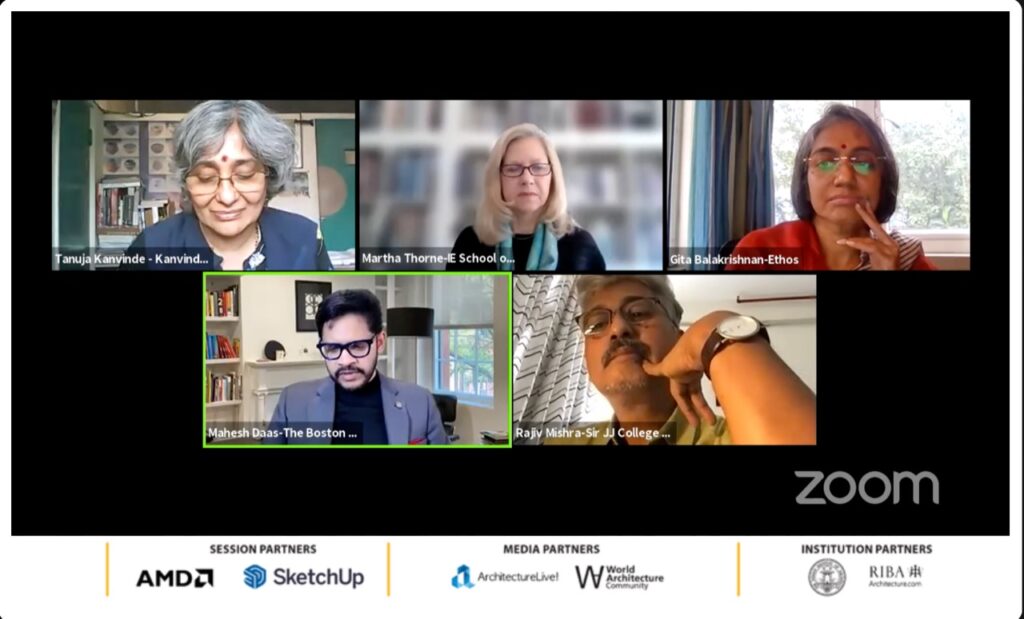
The second day of the ADM Summit focused on the theme of ‘Education & Careers’. The panel was to draw upon the idea of diversifying architectural design education and careers in the new age. Education in creative professions, such as architecture and design, is more about learning experientially and less about learning from knowledge.
The panel included IE School of Architecture and Design dean Martha Thorne (Madrid), The Boston Architectural College ACSA distinguished professor and DPACSA president Mahesh Daas (Boston), Ethos founder Gita Balakrishnan (Kolkata) and Sir JJ College of Architecture principal Rajiv Mishra (Mumbai). The session was moderated by Kanvinde Rai & Chowdhury partner Tanuja Kanvinde (Delhi).
In a very enlightening discussion, the industry doyens and educators dealt upon amazing facts about their institutions, how they try to fill in the existing gaps in the field of architecture and in a broad way highlighted how everyone should understand the term ‘Education’.
Setting the tone for the discussion on architectural education and its various roles, Kanvinde said, “The environment and the habitats that we inhabit have to be stable, sustainable and adaptable for the changing unpredictable scenarios: the climate change, rapid urbanisation and natural disasters. To this end architecture and design play a very important role. This has thrown new challenges to students, practitioners, academia; we have to redesign ourselves and be more resilient.”
“The field of architecture, design and construction is undergoing significant transformations and our learning also needs to keep pace with this change. There is a need for a diverse set of skills in this industry,” Balakrishnan, who helmed an online learning initiative- Acedge, said.
“Along the journey of Ethos for the last 18-19 years, one noticed large gaps in learning and mentoring between different locations and institutions owing to various reasons. Acedge was conceptualised to bridge those gaps and to democratise learning in the sense, to create some kind of a level-playing field, if possible, for students from different locations,” she said.
Balakrishnan very strongly believes that explorations outside academics are also a very essential tool of learning. “Many think learning is a process. I think learning is an attitude,” she exclaimed.
Talking about the role of technology in education, especially in the past few months, Mishra said, “Pandemic has actually been a boon. Students have become bolder. Now they express themselves online very boldly. I think they can now project their design ideas without fear.”
“Last twenty months have challenged us in many ways. We have been shaken out of our comfort zones and had to look at things very differently. This has pushed us for more innovative ways of functioning,” Kanvinde pointed out.

Online teaching is not new at IE School of Architecture and Design.
“We are kind of a unique school; we are the daughter of a business school. The university was created in 2007 but the business school was created 50 years ago. The technology is important because the business school began teaching online about 20 years ago. They tried to institute a more flexible way of teaching,” Thorne said.
“As we transitioned to a hybrid way of teaching, one thing that I saw was amazing was that often, the students were the leaders in experimenting with new platforms. Young people know technology and they use it in a seamless way,” she said.
Almost everyone stressed on the holistic-development of students. They should simply not be degree holders. It is important for students of architecture and design to think on a broader spectrum.
“It is about understanding the context in which you are operating. That context traditionally has been the climate, the place, the history, the culture and the social context,” Thorne said.
Stressing about the importance of students being future ready, she mentioned, “Next to all the skills, probably the most profound one is critical thinking. Students need to understand the impact of their actions from both, a very local/individual scale to the global scale.”
“The educational model continues to be very unique. We call it the concurrent education model, where the students learn from an academic setting as well as practice studying concurrently,” Daas mentioned while talking about their way of teaching in Boston Architectural College.
Mishra highlighted how everyone has been benefited by the New Education Policy in India which is actually promoting a multi-disciplinary approach towards thinking.
“We find the time ahead very exciting. Not only multidisciplinary but also the architect who is coming out, is not only a graduate of architecture, but a new architect with multiple talents,” Mishra exclaimed.
Giving an instance of maintaining diversity of students in their institute, Daas said, “27 per cent of our students come from 45 countries around the world.”
Students from underprivileged backgrounds and different other fields also come to Boston Architectural College. The 130 year-old college started as Boston Architectural club, where people could get together, talk and learn things about architecture and design.
In India, although there are many graduating, there is a lack of readiness of employability. Also, the industry is not ready to absorb the numbers that are coming in. Hence, everyone laid stress on the importance of students’ choice of subjects. They also mentioned that even ‘Exit policy’ is helpful. It means that a student can simply opt to graduate with a Bachelors degree and not do the entire architecture course.
Advocating the new age education mantra, Daas mentioned that education should not have boundaries. Mishra mentioned education should create more opportunities through proper application of technology and how community participation can actually teach the students, so he encourages more interaction outside the classroom.
During the ADM summit, the panel even spoke about the faculties being the backbone of any institution. Also, a healthy-teacher student relationship is mandatory to actually open multiple horizons.
